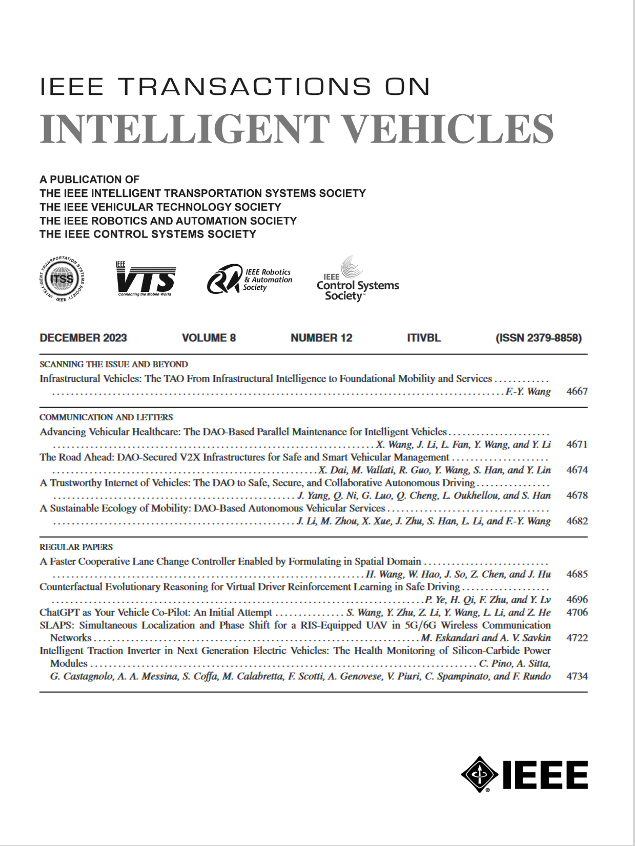Autonomous Mining Transportation Systems: Integrating 4D mmWave Radar for Enhanced Detection of Obstructed Static Objects
IF 14.3
1区 工程技术
Q1 COMPUTER SCIENCE, ARTIFICIAL INTELLIGENCE
引用次数: 0
Abstract
‘‘Mining 5.0,” in response to “Industry 5.0,” requires autonomous haulage systems to operate fully autonomously in open-pit mines. Current autonomous mining transportation systems rely on wireless transmission for edge dumping operations, which is inefficient and poses risks of potential communication loss and cybersecurity issues. Sensors such as LiDAR, cameras, and 3D mmWave radar do not support autonomous haulage to complete automation of edge dumping, as they struggle to detect obscured static obstacles and operate in harsh mining environments. We propose an innovative approach to address this challenge: integrating 4D mmWave radar into autonomous haulage systems. We have collected the world's first 4D mmWave radar dataset in the open pit mine to evaluate this approach, including four haulage operating scenarios under various lighting conditions. To quantify the precision of the 4D mmWave radar, we induce three points cloud comparison methods, a static object tracking algorithm, and point cloud image comparison to assess the system's ability to detect obscured static obstacles. Based on our findings, we conclude that using 4D mmWave radar enhances the autonomous haulage system's ability to detect obscured static obstacles in open pit mines, particularly at dumping sites.自主采矿运输系统:集成4D毫米波雷达以增强对受阻静态物体的检测
作为对“工业5.0”的回应,“采矿5.0”要求自动运输系统在露天矿中完全自主运行。目前的自动采矿运输系统依赖于无线传输进行边缘倾倒作业,效率低下,并且存在潜在的通信丢失和网络安全问题。激光雷达、摄像头和3D毫米波雷达等传感器不支持自动运输来完成边缘倾倒的自动化,因为它们很难检测到模糊的静态障碍物,并且在恶劣的采矿环境中运行。我们提出了一种创新的方法来应对这一挑战:将4D毫米波雷达集成到自动运输系统中。我们在露天矿中收集了世界上第一个4D毫米波雷达数据集来评估这种方法,包括不同照明条件下的四种运输操作场景。为了量化4D毫米波雷达的精度,我们归纳了三种点云比较方法、一种静态目标跟踪算法和点云图像比较,以评估系统检测被遮挡的静态障碍物的能力。根据我们的研究结果,我们得出结论,使用4D毫米波雷达可以增强自动运输系统探测露天矿中隐蔽的静态障碍物的能力,特别是在垃圾场。
本文章由计算机程序翻译,如有差异,请以英文原文为准。
求助全文
约1分钟内获得全文
求助全文
来源期刊

IEEE Transactions on Intelligent Vehicles
Mathematics-Control and Optimization
CiteScore
12.10
自引率
13.40%
发文量
177
期刊介绍:
The IEEE Transactions on Intelligent Vehicles (T-IV) is a premier platform for publishing peer-reviewed articles that present innovative research concepts, application results, significant theoretical findings, and application case studies in the field of intelligent vehicles. With a particular emphasis on automated vehicles within roadway environments, T-IV aims to raise awareness of pressing research and application challenges.
Our focus is on providing critical information to the intelligent vehicle community, serving as a dissemination vehicle for IEEE ITS Society members and others interested in learning about the state-of-the-art developments and progress in research and applications related to intelligent vehicles. Join us in advancing knowledge and innovation in this dynamic field.
 求助内容:
求助内容: 应助结果提醒方式:
应助结果提醒方式:


